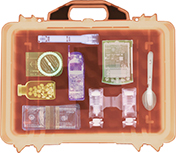Quick Lab
Evaluating Sunscreen
Procedure
Insert a black paper strip inside each of two plastic petri dishes to cover the sides. Place six ultraviolet-detecting beads in each dish. Cover each dish with its lid.
On one of the lids, spread a thin layer of sunscreen.
Place the dishes in direct sunlight. Record the time it takes for the beads in each dish to change color.

Analyze and Conclude
Comparing and Contrasting Compare the times the beads in the two dishes took to change color.
Using Models Explain how this lab models the use of sunscreen. What does the color change of the beads represent?
Predicting How might a sunscreen with a higher SPF (sun protection factor) affect the time needed for the beads to change color?
Ultraviolet Rays
The wavelengths of ultraviolet rays vary from about 400 nanometers to about 4 nanometers. Ultraviolet radiation has higher frequencies than violet light.  Ultraviolet rays have applications in health and medicine, and in agriculture.
Ultraviolet rays have applications in health and medicine, and in agriculture.
In moderation, exposure to ultraviolet rays helps your skin produce vitamin D. Vitamin D helps the body absorb calcium from foods to produce healthy bones and teeth. Excessive exposure can cause sunburn, wrinkles, and eventually skin cancer. It can also damage your eyes.
Ultraviolet rays are used to kill microorganisms. In heating and cooling systems of large buildings, ultraviolet rays disinfect the air that flows through the systems. In winter, plant nurseries use ultraviolet lights to help plants grow.
X-Rays
X-rays have very short wavelengths, from about 12 nanometers to about 0.005 nanometers. They have higher frequencies than ultraviolet rays. X-rays have high energy and can penetrate matter that light cannot.  X-rays are used in medicine, industry, and transportation to make pictures of the inside of solid objects.
X-rays are used in medicine, industry, and transportation to make pictures of the inside of solid objects.
Your teeth and bones absorb X-rays. X-ray photographs show softer tissue as dark, highly exposed areas. Bones and teeth appear white. Too much exposure to X-rays can kill or damage living tissue.
The lids on aluminum cans are sometimes inspected with X-rays to make sure they are sealed properly. X-rays can be used to identify the contents of entire truck trailers. Packages and suitcases, such as the one in Figure 14, are X-rayed in search of dangerous contents.
What are X-rays used for?
Figure 14 Airport security screeners use X-rays to search baggage for potentially dangerous objects.
Inferring Why are there dark areas in this X-ray image?







